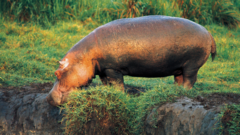In a shocking event reported from Africa's oldest national park, Virunga in the Democratic Republic of Congo, officials have confirmed the deaths of at least 50 hippos and several other large animals attributed to anthrax poisoning. Images from the park depict the lifeless bodies of the hippos floating in the Ishasha River, with reports stating that sightings of the deceased animals began last week. Although the precise origins of the outbreak remain unclear, tests conducted have validated the presence of anthrax, a disease caused by the bacteria Bacillus anthracis.
Park director Emmanuel de Merode has indicated that efforts are in place to safely recover and bury the carcasses to mitigate further contamination, albeit hindered by logistical challenges and a lack of excavators. De Merode expressed concerns about accessibility, stating, "We have the means to limit the spread by... burying them with caustic soda." The Ishasha River leads to Lake Edward, where additional reports of dead wildlife have emerged, prompting warnings from the Congolese Institute for the Conservation of Nature. Residents are advised to steer clear of wild animals and to boil water collected from local sources before consumption.
At 7,800 square kilometers in size, Virunga National Park is renowned for its biodiversity but is also notorious for the dangers posed by armed conflict in the region. The park remains a significant tourist attraction yet has been plagued by clashes between various militia groups and the Congolese army, as they vie for control over valuable resources. These ongoing conflicts have resulted in the tragic loss of lives among wildlife rangers dedicated to preserving the park's natural heritage.
Efforts in recent years have aimed to reverse the dramatic decline of the hippo population in Virunga, which plummeted from over 20,000 to just a few hundred due to poaching and warfare. The current anthrax outbreak underscores the imperative for continued focus on wildlife protection in the face of both human conflict and environmental threats.
Park director Emmanuel de Merode has indicated that efforts are in place to safely recover and bury the carcasses to mitigate further contamination, albeit hindered by logistical challenges and a lack of excavators. De Merode expressed concerns about accessibility, stating, "We have the means to limit the spread by... burying them with caustic soda." The Ishasha River leads to Lake Edward, where additional reports of dead wildlife have emerged, prompting warnings from the Congolese Institute for the Conservation of Nature. Residents are advised to steer clear of wild animals and to boil water collected from local sources before consumption.
At 7,800 square kilometers in size, Virunga National Park is renowned for its biodiversity but is also notorious for the dangers posed by armed conflict in the region. The park remains a significant tourist attraction yet has been plagued by clashes between various militia groups and the Congolese army, as they vie for control over valuable resources. These ongoing conflicts have resulted in the tragic loss of lives among wildlife rangers dedicated to preserving the park's natural heritage.
Efforts in recent years have aimed to reverse the dramatic decline of the hippo population in Virunga, which plummeted from over 20,000 to just a few hundred due to poaching and warfare. The current anthrax outbreak underscores the imperative for continued focus on wildlife protection in the face of both human conflict and environmental threats.





















